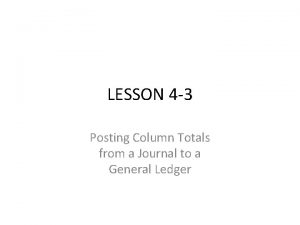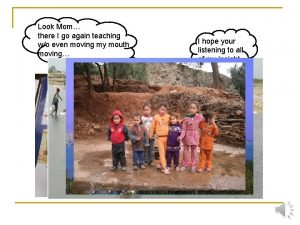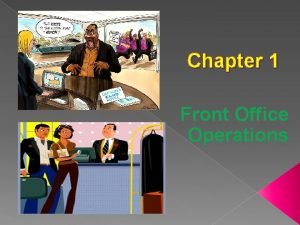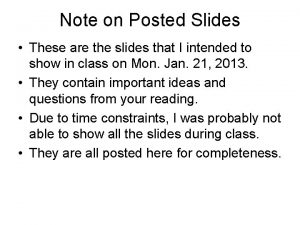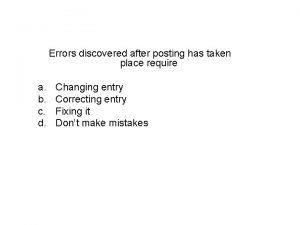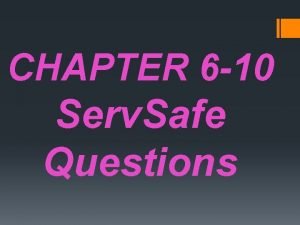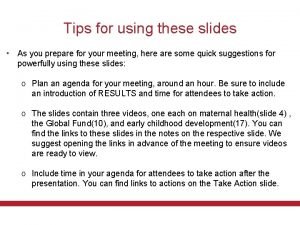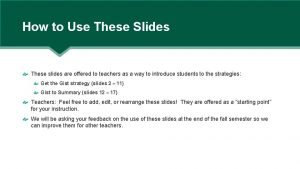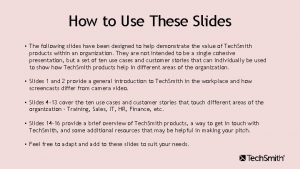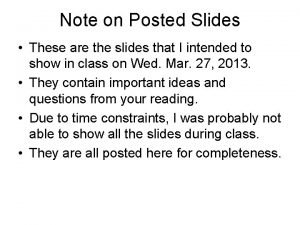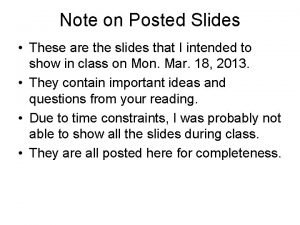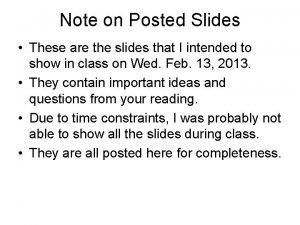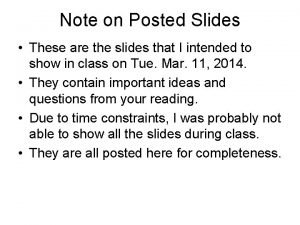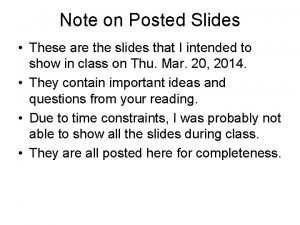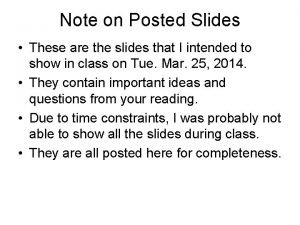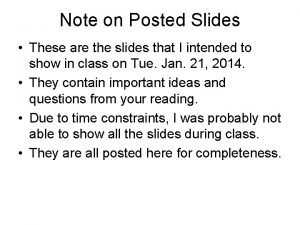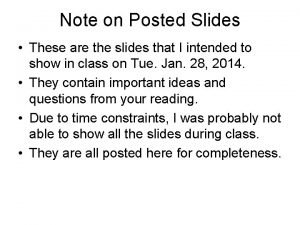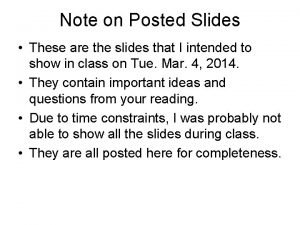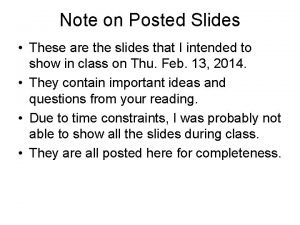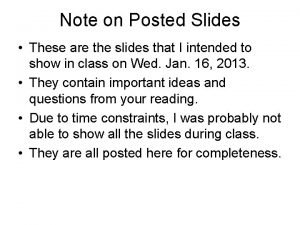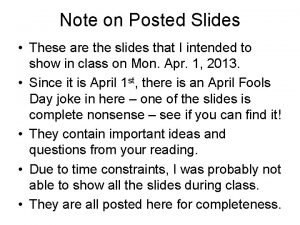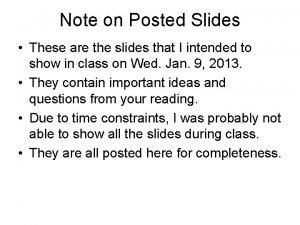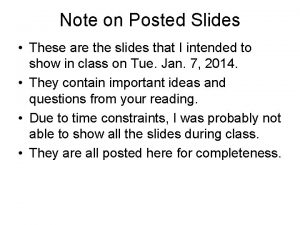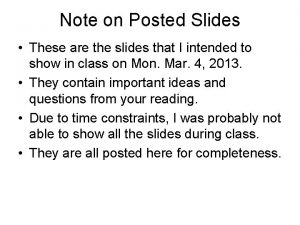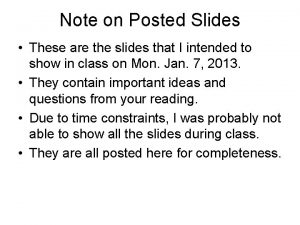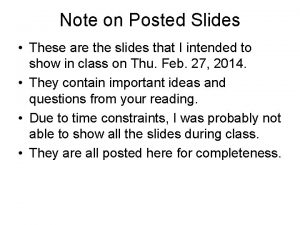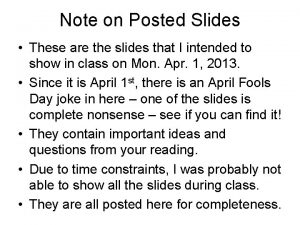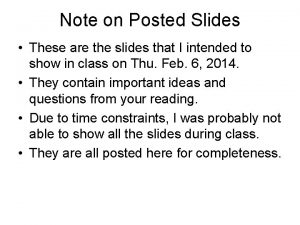Note on Posted Slides These are the slides













































- Slides: 45

Note on Posted Slides • These are the slides that I intended to show in class on Thu. Mar. 27, 2014. • They contain important ideas and questions from your reading. • Due to time constraints, I was probably not able to show all the slides during class. • They are all posted here for completeness.

PHY 205 H 1 S Physics of Everyday Life Class 20: The Properties of Light • • • The History of Light Electromagnetic Waves The Electromagnetic Spectrum Transparent Materials Opaque Materials Seeing Light—The Eye © 2010 Pearson Education, Inc.

History of Light § 300 B. C. – Euclid of Alexandria noted that light travels in straight lines, and wrote down the Law of Reflection for plane mirrors. § Unfortunately, Euclid believed that vision was due to our eyes emitting rays of light.

History of Light § 1000 A. D. – Alhazen of Basra considered the law of reflection in 3 -D, noting that the angles of incidence and reflection are in the same plane normal to the interface. § Alhazen proved experimentally that vision is due to light proceeding from objects into our eyes. [image from http: //www. clker. com/clipart-plane-of-incidence. html ]

History of Light § 1665 – Isaac Newton used a glass prism to disperse light and create a rainbow. He concluded that white light was composed of a mixture of a whole range of colours. § Unfortunately, Newton advocated the idea that light was a stream of particles, not a wave phenomenon.

History of Light § 1814 – Jean Fresnel promoted a wave theory of light, to explain fuzzy shadows, and interference. § Fresnel modelled light as a transverse wave (in something called the “aether”) and successfully predicted amplitudes of reflected and transmitted light from glass interfaces. § These successes convinced the scientific community that light was definitely a wave phenomenon.

History of Light § 1864 – James Clerk Maxwell published his equations describing the dynamic relations of the electric and magnetic fields. § Maxwell showed that disturbances in the electric and magnetic fields could propagate as a transverse wave, and he solved for theoretical speed of this wave. § This speed was very close to the current experimental value, justifying his theory that light was an electromagnetic wave.

History of Light § 1905 – Albert Einstein explained the photoelectric effect by proposing that light could only be delivered in globs or “particles” of energy (photons). § This lead to theory of Quantum Mechanics, which states that every particle moves according to a wave equation which gives the probability density of its future location. § Thus, light is correctly understood as a stream of particles! But tiny particles move like waves.

Electromagnetic Waves Any time you shake an electrically charged object back and forth, you produce an electromagnetic wave.

Electromagnetic Waves CHECK YOUR NEIGHBOUR •

Electromagnetic Waves The electric and magnetic fields of an electromagnetic wave are perpendicular to each other and to the direction of motion of the wave.

Electromagnetic Waves CHECK YOUR NEIGHBOUR If an electron vibrates up and down 1000 times each second, it generates an electromagnetic wave with a A. B. C. D. period of 1000 s. speed of 1000 m/s. wavelength of 1000 m. None of the above.

Electromagnetic Spectrum • In a vacuum, all electromagnetic waves move at the same speed • We classify electromagnetic waves according to their frequency (or wavelength) • Light is one kind of electromagnetic wave

Electromagnetic Spectrum • The lowest frequency (and longest wavelength) light our eyes can see appears red • As the frequency increases, the light goes through the colors: orange, yellow, green, blue, violet • Violet light has nearly twice the frequency of red light, and half the wavelength

Electromagnetic Waves CHECK YOUR NEIGHBOUR If a certain material is “transparent” (ie, not opaque), what does this mean? A. Electromagnetic waves of all frequencies can pass straight through it B. Electromagnetic waves of all frequencies are reflected from its surface C. Electromagnetic waves of all frequencies are absorbed throughout its volume D. Electromagnetic waves of a certain frequency can pass straight through it

Transparent Materials Glass blocks both infrared and ultraviolet, but it is transparent to visible light.

Refraction of Light CHECK YOUR NEIGHBOUR • When light passes from water into air or vice-versa, it can bend its direction (making the spoon look broken below). • What causes this bending of the light rays? A. Absorption due to resonance B. Change in wave speed C. Reflection D. Scattering from small particles E. Selective transmission

Light is transmitted similarly to sound. • Both are vibrations due to a vibrating source.

• Photons can only travel at exactly the speed of light. • Each photon is absorbed an re-emitted each time it encounters an atom in a transparent material. • Averaged over many molecules, light travels more slowly through a transparent material than through a vacuum.

Transparent Materials Average speed of light through different materials • Vacuum: c = 300, 000 m/s • Atmosphere: slightly less than c (but rounded off to c) • Water: 0. 75 c • Glass: 0. 67 c, depending on material • Diamond: 0. 41 c

Transparent Materials CHECK YOUR NEIGHBOUR Compared with the frequency of illuminating light on a piece of clear glass, the frequency of light that is transmitted into the glass A. is less. B. is the same. C. is higher.

Opaque Materials • Most things around us are opaque—they absorb light without re-emitting it. • Vibrations given by light to their atoms and molecules are turned into random kinetic energy—into internal energy. • These materials become slightly warmer.

Opaque Materials Metals • Light shining on metal forces free electrons in the metal into vibrations that emit their own light as reflection.

Reflection CHECK YOUR NEIGHBOUR Which reflects more light, a white piece of paper or a black piece of paper? A. Black B. White C. About the same

Reflection CHECK YOUR NEIGHBOUR Which reflects more light, a white piece of paper or a mirror? A. White Paper B. Mirror C. About the same

Mirror versus White Paper Mirrors • The surface is flat at distance scales near or above the wavelength of light • It looks “shiny”, and you can see images in it.

Mirror versus White Paper • The surface is rough at distance scales near or above the wavelength of light • Almost all surfaces reflect in this way!

Reflection CHECK YOUR NEIGHBOUR Harlow is looking at his daughter, Zainab. In terms of what physically allows him to see her, which arrow is best? A B

Rays and Shadows • A very distant or small light source will produce a sharp shadow. • A larger or more nearby light source produces a blurry shadow.

Shadows The dark part inside a shadow where the light is totally blocked is called an umbra. The penumbra is a lighter part around the edges of a shadow, where light from a broad source is only partially blocked.

Reflection CHECK YOUR NEIGHBOUR The photo shows a heavily filtered image of the sun during a partial solar eclipse. What is physically happening to cause this eclipse? A. Only the penumbra of the Earth’s shadow is falling on the moon. B. Part of the umbra of the Earth’s shadow is falling on the moon. C. The photographer is standing in the penumbra of the shadow of the moon which is falling on the Earth. D. The photographer is standing in the umbra of the shadow of the moon which is falling on the Earth.

Reflection CHECK YOUR NEIGHBOUR The photo shows an image of the moon during a partial lunar eclipse. What is physically happening to cause this eclipse? A. Only the penumbra of the Earth’s shadow is falling on the moon. B. Part of the umbra of the Earth’s shadow is falling on the moon. C. The photographer is standing in the penumbra of the shadow of the moon which is falling on the Earth. D. The photographer is standing in the umbra of the shadow of the moon which is falling on the Earth.

Total Solar Eclipse of August 21, 2017. Do NOT miss it! …where will I be in 4 years from this summer? Driving to Nashville, Tennesee!

Total Solar Eclipse of August 21, 2017. Do NOT miss it!


Insect eyes are compound! Each ommatidium sends separate information to their brain. Ommatidia are the functional units of insect eyes. Ommatidia contain receptor cells that send axons to the insect’s brain. Lens Receptor cells Axons Slide courtesy of Ross Koning, Biology Department, Eastern Connecticut State University http: //plantphys. info/sciencematters/vision. ppt


Copyright Norton Presentation Manager Human vs Insect Vision Slide courtesy of Ross Koning, Biology Department, Eastern Connecticut State Univ http: //plantphys. info/sciencematters/vision. ppt

Seeing Light – The Eye The retina is composed of tiny antennae that resonate to the incoming light. • Rods handle vision in low light. – They predominate toward the periphery of the retina. • Cones handle color vision and detail. – They are denser toward the fovea. – There are three types of cones, stimulated by low, intermediate and high frequencies of light.

Retina § The retina is filled with rods and cones § The spot where the optic nerve exits contains no receptors and is insensitive to light: blind spot (we don’t notice it because our brain fills in the gap with what it expects) § At the centre of the retina is the macula, which contains twice as many cones as rods § At the centre of the macula is the fovea centralis. It contains no rods, and the cones are very densely packed. § We constantly move our eyeballs to cause the light coming from the object of primary interest to fall on the fovea centralis.

Use right eye only (close left eye)…focus only on the target for this test! Lock head in position…hold one finger up at arm’s length to cover view of target Move arm slowly to the right, away from the target Find your blind spot for that eye Slide courtesy of Ross Koning, Biology Department, Eastern Connecticut State Univ http: //plantphys. info/sciencematters/vision. ppt

Use right eye only (close left eye)…our target is a row of numbers 1 2 3 4 5 6 7 8 9 Focus on each number in turn, until the break in the blue lines is in your blind spot. What is different when the blind spot holds a blank area? Slide courtesy of Ross Koning, Biology Department, Eastern Connecticut State Univ http: //plantphys. info/sciencematters/vision. ppt

Seeing Light – The Eye • Although our vision is poor from the corner of our eye, we are sensitive to anything moving there.

Optical Illusions CHECK YOUR NEIGHBOUR Which half of this box is a lighter shade of gray? A. The left half B. The right half C. Both halves are exactly the same shade of gray D. I cannot tell!

Before class on Tuesday • Please read Chapter 27, or at least watch the 10 -minute pre-class video for class 20. In honor of April Fool’s Day, there is a joke in Tuesday’s slides. One slide looks real, but the information in it is complete nonsense! See if you can find it! • Something to think about: • Why are there exactly 3 “primary colours”? What physical property of the universe causes this?
 Antigentest åre
Antigentest åre Debit note
Debit note Difference between note making and note taking
Difference between note making and note taking Linear method of note taking
Linear method of note taking Goods received note vs delivery note
Goods received note vs delivery note Simple discount example
Simple discount example Difference between note making and note taking
Difference between note making and note taking Debit note format
Debit note format Signal words for cause and effect
Signal words for cause and effect Which column totals of a journal are posted?
Which column totals of a journal are posted? Signage posted at a handwashing station must include
Signage posted at a handwashing station must include Look mom europe
Look mom europe Folio bucket in front office
Folio bucket in front office Examples of momentum
Examples of momentum Errors discovered after posting has taken place requires
Errors discovered after posting has taken place requires What is an infrared thermometer best used for servsafe
What is an infrared thermometer best used for servsafe A small child slides down the four frictionless slides
A small child slides down the four frictionless slides Final energy quick check
Final energy quick check These slides
These slides These slides
These slides Following slides
Following slides Nguyên nhân của sự mỏi cơ sinh 8
Nguyên nhân của sự mỏi cơ sinh 8 Vẽ hình chiếu đứng bằng cạnh của vật thể
Vẽ hình chiếu đứng bằng cạnh của vật thể Phản ứng thế ankan
Phản ứng thế ankan Voi kéo gỗ như thế nào
Voi kéo gỗ như thế nào Thiếu nhi thế giới liên hoan
Thiếu nhi thế giới liên hoan điện thế nghỉ
điện thế nghỉ Một số thể thơ truyền thống
Một số thể thơ truyền thống Thế nào là hệ số cao nhất
Thế nào là hệ số cao nhất Trời xanh đây là của chúng ta thể thơ
Trời xanh đây là của chúng ta thể thơ Số nguyên tố là số gì
Số nguyên tố là số gì đặc điểm cơ thể của người tối cổ
đặc điểm cơ thể của người tối cổ Phối cảnh
Phối cảnh Các châu lục và đại dương trên thế giới
Các châu lục và đại dương trên thế giới Tư thế worm breton là gì
Tư thế worm breton là gì ưu thế lai là gì
ưu thế lai là gì Sơ đồ cơ thể người
Sơ đồ cơ thể người Tư thế ngồi viết
Tư thế ngồi viết Bàn tay mà dây bẩn
Bàn tay mà dây bẩn Mật thư tọa độ 5x5
Mật thư tọa độ 5x5 Bổ thể
Bổ thể Tư thế ngồi viết
Tư thế ngồi viết Thẻ vin
Thẻ vin Ví dụ giọng cùng tên
Ví dụ giọng cùng tên Thể thơ truyền thống
Thể thơ truyền thống









